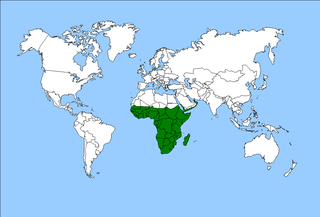
Meliaceae, the mahogany family, is a flowering plant family of mostly trees and shrubs in the order Sapindales.

The Afrotropical realm is one of the Earth's eight biogeographic realms. It includes Sub-Saharan Africa, the southern Arabian Peninsula, the island of Madagascar, and the islands of the western Indian Ocean. It was formerly known as the Ethiopian Zone or Ethiopian Region.

Hibiscus is a genus of flowering plants in the mallow family, Malvaceae. The genus is quite large, comprising several hundred species that are native to warm temperate, subtropical and tropical regions throughout the world. Member species are renowned for their large, showy flowers and those species are commonly known simply as "hibiscus", or less widely known as rose mallow. Other names include hardy hibiscus, rose of sharon, and tropical hibiscus.

Osteospermum, is a genus of flowering plants belonging to the Calenduleae, one of the smaller tribes of the sunflower/daisy family Asteraceae. They are known as the daisybushes or African daisies. Its species have been given several common names, including African daisy, South African daisy, Cape daisy and blue-eyed daisy.

Senecioneae is the largest tribe of the Asteraceae, or the sunflower family, comprising over 150 genera and over 3,500 species. Almost one-third of the species in this tribe are placed in the genus Senecio. Its members exhibit probably the widest possible range of form to be found in the entire plant kingdom, and include annuals, minute creeping alpines, herbaceous and evergreen perennials, shrubs, climbers, succulents, trees, and semi-aquatic plants.

The Papaveraceae are an economically important family of about 42 genera and approximately 775 known species of flowering plants in the order Ranunculales, informally known as the poppy family. The family is cosmopolitan, occurring in temperate and subtropical climates, but almost unknown in the tropics. Most are herbaceous plants, but a few are shrubs and small trees. The family currently includes two groups that have been considered to be separate families: Fumariaceae and Pteridophyllaceae. Papaver is the classical name for poppy in Latin.

Eugenia is a genus of flowering plants in the myrtle family Myrtaceae. It has a worldwide, although highly uneven, distribution in tropical and subtropical regions. The bulk of the approximately 1,100 species occur in the New World tropics, especially in the northern Andes, the Caribbean, and the Atlantic Forest of eastern Brazil. Other centers of diversity include New Caledonia and Madagascar. Many of the species that occur in the Old World have received a new classification into the genus Syzygium.

Harpagophytum, also called grapple plant, wood spider, and most commonly devil's claw, is a genus of plants in the sesame family, native to southern Africa. Plants of the genus owe their common name "devil's claw" to the peculiar appearance of their hooked fruit. Several species of North American plants in the genus Proboscidea and certain species of Pisonia, however, are also known by this name. Devil's claw's tuberous roots are used in folk medicine to reduce pain.

Gerbera L. is a genus of plants in the Asteraceae (Compositae) family. The first scientific description of a Gerbera was made by J. D. Hooker in Curtis's Botanical Magazine in 1889 when he described Gerbera jamesonii, a South African species also known as Transvaal daisy or Barberton daisy. Gerbera is also commonly known as the African daisy.

Zanthoxylum is a genus of about 250 species of deciduous and evergreen trees, shrubs and climbers in the family Rutaceae that are native to warm temperate and subtropical areas worldwide. It is the type genus of the tribe Zanthoxyleae in the subfamily Rutoideae. Several of the species have yellow heartwood, to which their generic name alludes. Several species are cultivated for their use as spices, notably including Sichuan pepper.

Prosopis juliflora is a shrub or small tree in the family Fabaceae, a kind of mesquite. It is native to Mexico, South America and the Caribbean. It has become established as an invasive weed in Africa, Asia, Australia and elsewhere. It is a contributing factor to continuing transmission of malaria, especially during dry periods when sugar sources from native plants are largely unavailable to mosquitoes.

Carissa is a genus of shrubs or small trees native to tropical and subtropical regions of Africa, Australia and Asia. Until recently about 100 species were listed, but most of them have been relegated to the status of synonyms or assigned to other genera, such as Acokanthera.

Gazania is a genus of flowering plants in the family Asteraceae, native to Southern Africa.

Cotula is a genus of flowering plant in the sunflower family. It includes plants known generally as water buttons or buttonweeds.
The anthophytes are a grouping of plant taxa bearing flower-like reproductive structures. They were formerly thought to be a clade comprising plants bearing flower-like structures. The group contained the angiosperms - the extant flowering plants, such as roses and grasses - as well as the Gnetales and the extinct Bennettitales.












